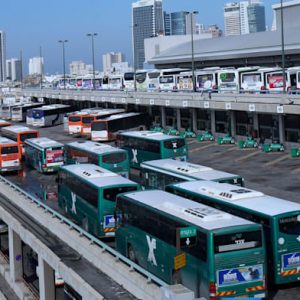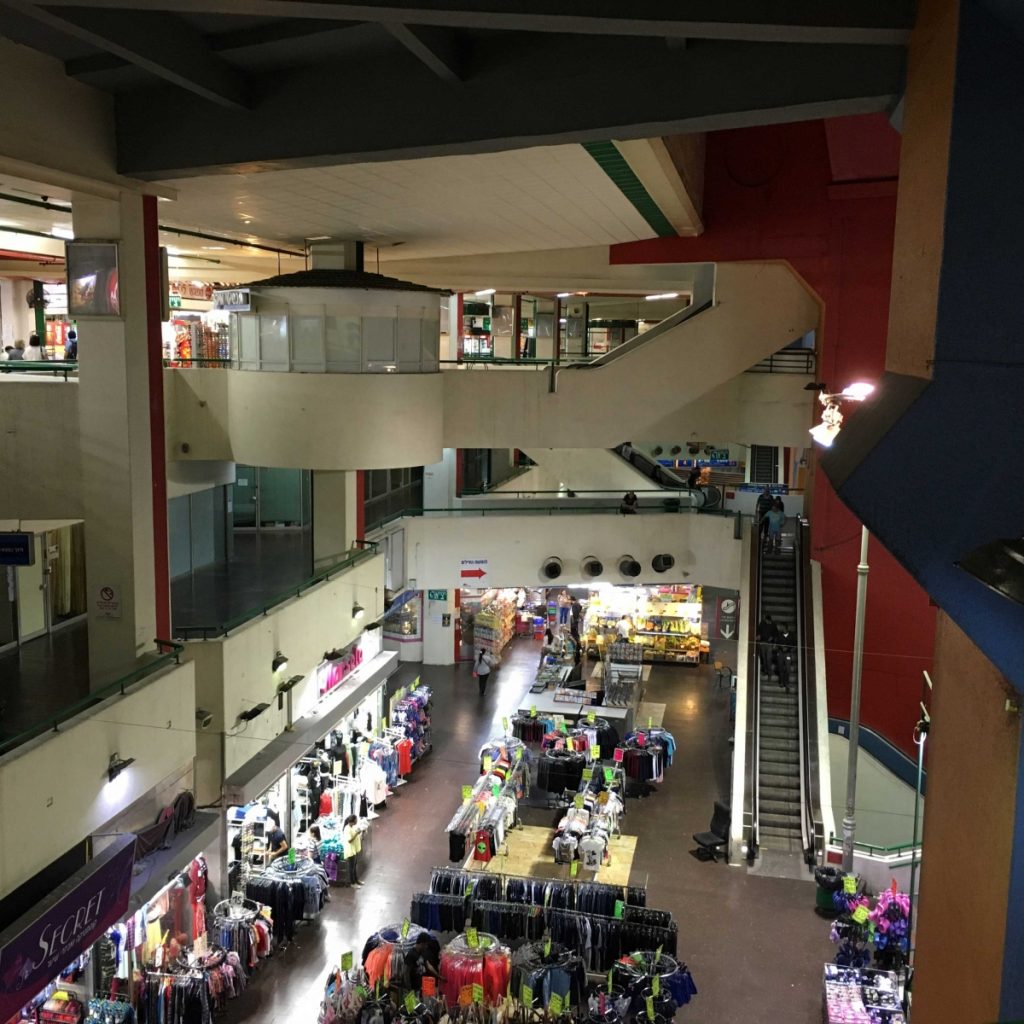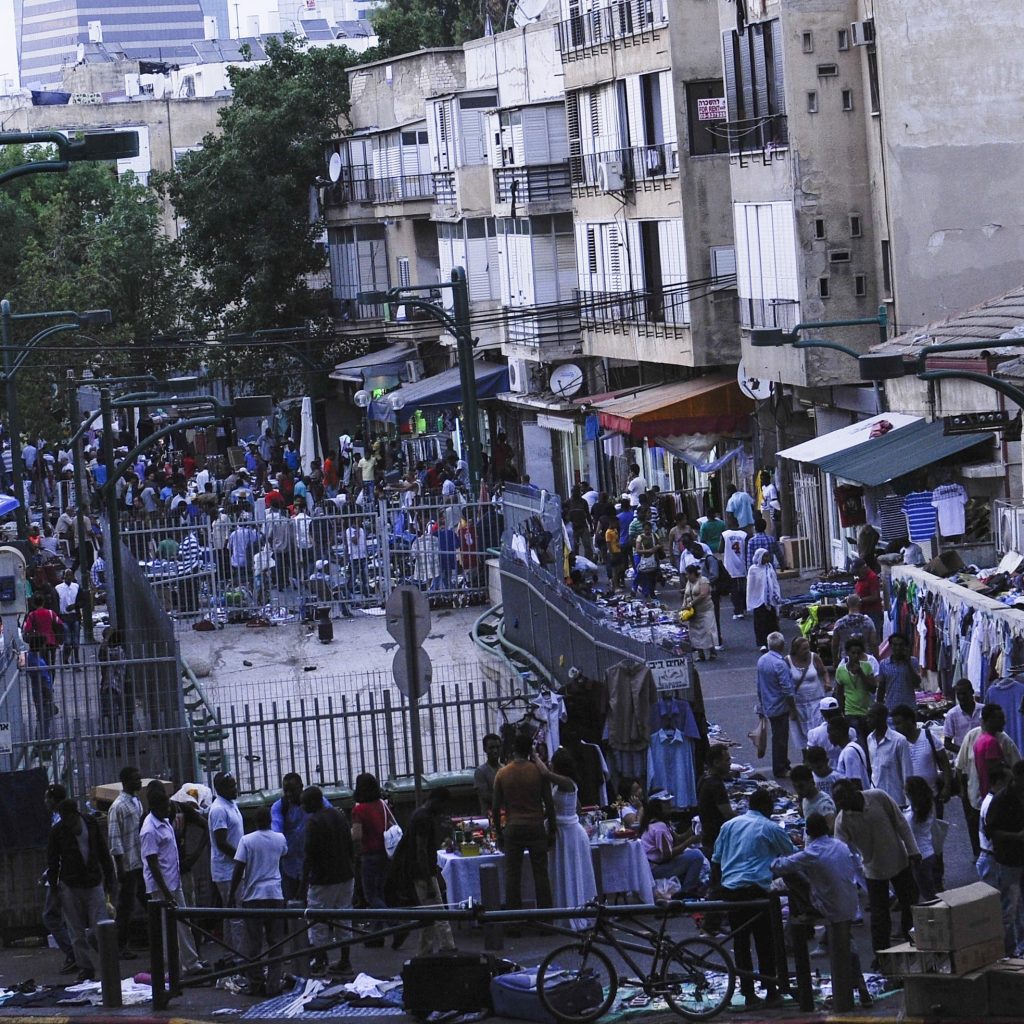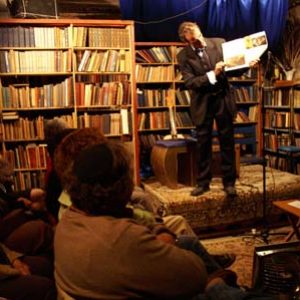– by Alexander Jones –
Stop me if this sounds familiar. You’re newly arrived in a foreign land. You’ve just stepped off a bus in Tel Aviv and need to get outside, eat a meal and find your hotel. The only thing between you and a soft pillow is the daunting maze that is the Central Bus Station. Looking for the exit doesn’t seem too much to ask, and yet 10, 20 and 30 minutes later you’re still wandering its often derelict corridors. Well dear readers, this experience common to many visitors and locals alike is about to become a memory. 54 miserable years since construction began, the Tel Aviv Municipality has announced it will finally close the Central Bus Station.

While Tel Aviv is the major hub for transportation in this part of Israel, the city’s population is less than half a million. In the 1960s when the bus station was first planned, the population was only slightly less than this and continued growth was expected. Thus, architect Ram Karmi was entrusted with building what eventually became a 230,000 m2 monolith on the south-eastern edge of the city. To put this into perspective, Grand Central Station in New York City is less than 200,000 m2 while India’s massive Mofussil Bus Station in Chennai, is less than 150,000 m2. Indeed today little Tel Aviv possesses the world’s largest bus station despite its modest population and the conspicuous lack of long distance journeys. The longest trip one can take from here is just 370km away to Eilat and there are no international services whatsoever.
Delays dogged the much maligned station from the start. Construction began in 1967 but the first bus trip wasn’t taken until 1993. Originally meant to have platforms on all five floors, neither of the two largest Israeli bus companies, Dan and Egged, wanted to have their departure platforms buried in the gloomy underground section. They also refused to share a floor, and thus a sixth and then seventh floor were added. In the end no company agreed to take the lower floors so the 1st and 2nd floors have never been used. The access ramps, escalators and stairs taking people up were deliberately made to be confusing, hoping this would create a sense of a city within the city where riders would want to spend more time mingling with one another, stopping to eat and drink, and of course, shopping. The idea was that the station would become as much a destination in its own right as a place where a journey simply begins or ends.

Architect Ram Karmi is the son of the first Israel Prize winning architect: legendary Dov Karmi. Karmi the elder is credited with giving the young Tel Aviv its now world famous ‘international’ style. He was part of a young generation inspired (and in a few cases, actually trained at) Germany’s Bauhaus School where form was taught as being subservient to function. If a feature wasn’t necessary on a building, it was gone. He designed many homes which are now listed as UNESCO World Heritage Sites as well as the Knesset (Israel’s parliament in Jerusalem) and the home of the Israel Philharmonic Orchestra in Tel Aviv (Heichal HaTarbut, literally the ‘culture palace’). The younger Ram initially worked alongside his father and sister, with whom he designed the Israeli Supreme Court in 1992 and for which they won their own Israel Prizes.
Soon after, however, he fully adopted the brutalist style and promptly dotted several awful white elephants around the country. In the 1990s he built the massive Holyland Apartment Complex in Jerusalem, dubbed ‘the horror on the hill’. It engulfed many high profile figures in controversy including Israeli Prime Minister Ehud Olmert (who was charged with bribery and money laundering) and Jerusalem major Uri Lupolianski (who was charged with corruption). Both of them did prison time around the illegal rezoning which made the project possible. Later, in the 2000s, Karmi’s renovation of HaBima Theatre in Tel Aviv was awarded to him without due process. It eventually went five times over budget and was also widely criticised. But his Central Bus Station is surely the most unappealing.
It was built in the working class Neve Sha’anan neighbourhood. The bus station hindered development here so totally that today it is mostly home to migrant workers and asylum seekers. Drugs, prostitution and crime exist here in quantities unseen in other parts of Tel Aviv. Prestigious Rothschild Boulevard is just a few minutes walk away, but you would struggle to believe Tel Aviv is the world’s most expensive city if strolling from here to the bus station. The air pollution is so bad in the vicinity of the station, as old buses change down gears to groan up steep ramps, that a recent study found that CO2 levels on nearby Levinsky Street were 30% higher than the nationally acceptable standard.

New transportation minister, Labour leader Merav Michaeli, made it her mission to close the station. Supported by Meretz’s Environment Minister Tamar Zandberg, they announced plans to increase park’n’ride stations on the outskirts of the city, introduce more electric buses and build a new terminal near the Panorama Center along the beach in north Tel Aviv. They say this will happen by 2023 but give no indication of what will happen to the hundreds of tonnes of concrete or the 1000 plus people who work in the station every day. Michaeli admits demolition is unlikely to be possible.
Despite its serious shortcomings and hundreds of empty stores, currently the bus station nevertheless hosts some remarkable spots. It’s the best place in town to try halo halo; the Filipino dessert of crushed ice, condensed milk, and jellies, which has recently been taking Instagram by storm. It’s home to the ‘Yung Yidish’ Cultural Center; a library, performance space and museum preserving pre-Holocaust European Jewish culture and teaching the Yiddish language to a new generation. Migrant workers receive legal help and can book flights home from affordable offices based here. You can find a rare bat colony in the bottom two floors. There’s a street art gallery on the top. But talking to some of the people who work in the station, the frustration of life here over the past decades is matched only by the frustration they feel about the future. They have been given no information about what happens next and have no idea where they will go.

Motti, a shop keeper in the busy main floor who sells clothes, says there has been talk about closing the building for years but he doesn’t believe it will ever happen. He admits he hates the building, but doesn’t think he’ll be going anywhere new any time soon. Founder of the Yiddish center, singer Mendy Cahan, runs his remarkable, ramshackle space on a shoestring budget and with help from volunteers. Just last year their precious collection of books, photographs and other memories of Ashkenazi life were professionally filed and organised on dozens of brand new, three metre-high, shelving units. There is no way they can afford a new space in the brutal Tel Aviv real estate market if the bus station closes.
It seems likely that the tragedy that is the Central Bus Station will claim another few victims before it finally disappears. Until then, the latest announcement is that bus lines will gradually be moved from the station to elsewhere in the city but exactly where, when and how all remain unanswered questions.
Green Olive can provide private tours of South Tel Aviv, including the central bus station. Click here for more information!

Customer
Viagra levitra https://motocom.co/demos/netw5/askme/question/canadian-pharmaceuticals-online-5/
With thanks. I enjoy it.
Customer
canadian medications https://www.midi.org/forum/profile/89266-canadianpharmaceuticalsonline
You actually revealed that wonderfully!
Customer
stromectol order https://tropkefacon.estranky.sk/clanky/buy-ivermectin-fitndance.html
Wonderful material. Kudos!
Customer
Buy generic viagra https://theosipostmouths.estranky.cz/clanky/stromectol-biam.html
Useful posts. With thanks!
Customer
buy ivermectin online https://challonge.com/bunmiconglours
Many thanks! Numerous forum posts!
Customer
Viagra bula https://www.provenexpert.com/medicament-stromectol/
Amazing loads of awesome advice!
Customer
Viagra vs viagra https://pinshape.com/users/2491694-buy-stromectol-fitndance
Beneficial write ups. With thanks!
Customer
Viagra generika https://aoc.stamford.edu/profile/cliclecnotes/
Whoa loads of great data.
Customer
Viagra 5mg https://reallygoodemails.com/orderstromectoloverthecounterusa
Useful knowledge. Thank you.
Customer
Viagra for sale https://feeds.feedburner.com/bing/stromectolnoprescription
You explained it very well!
Customer
5 mg viagra coupon printable https://canadianpharmaceuticalsonline.as.me/schedule.php
Good data, Regards.
Customer
Viagra generika https://results.excite.com/serp?q=“My Canadian Pharmacy – Extensive Assortment of Medications – 2022”
Helpful stuff. Many thanks.
Customer
Tadalafil https://headwayapp.co/canadianppharmacy-changelog
Many thanks. Valuable information.
Customer
canada drug https://www.infospace.com/serp?q=“My Canadian Pharmacy – Extensive Assortment of Medications – 2022”
Nicely put, Thank you!
Customer
Viagra 5mg prix https://results.excite.com/serp?q=“My Canadian Pharmacy – Extensive Assortment of Medications – 2022”
Superb posts. Many thanks.
Customer
Viagra online
This is nicely expressed! !
Customer
Viagra generika https://www.bakespace.com/members/profile/Сanadian pharmaceuticals for usa sales/1541108/
Seriously lots of fantastic info.
Customer
Viagra reviews https://search.givewater.com/serp?q=“My Canadian Pharmacy – Extensive Assortment of Medications – 2022”
Kudos! Ample advice!
Customer
online pharmacies canada
Incredible quite a lot of wonderful knowledge.
Customer
Viagra daily https://www.dogpile.com/serp?q=“My Canadian Pharmacy – Extensive Assortment of Medications – 2022”
This is nicely put. .
Customer
Viagra sans ordonnance https://swisscows.com/en/web?query=“My Canadian Pharmacy – Extensive Assortment of Medications – 2022”
Awesome facts. Appreciate it.
Customer
Generic viagra
With thanks, I like it!
Customer
Viagra canada https://sanangelolive.com/members/unsafiri
Perfectly expressed certainly. .
Customer
How does viagra work https://search.seznam.cz/?q=“My Canadian Pharmacy – Extensive Assortment of Medications – 2022”
Wow many of terrific info.
Customer
Low cost viagra 20mg https://search.gmx.com/web/result?q=“My Canadian Pharmacy – Extensive Assortment of Medications – 2022”
Nicely put, Regards!
Customer
Buy viagra https://www.giantbomb.com/profile/canadapharmacy/blog/canadian-pharmaceuticals-online/265652/
You actually stated it perfectly!
Customer
Cheap viagra https://seedandspark.com/user/canadian-pharmaceuticals-online
Thanks! A lot of data.
Customer
Viagra coupon https://www.mojomarketplace.com/user/Canadianpharmaceuticalsonline-EkugcJDMYH
Terrific content. Thanks a lot.
Customer
canadian pharcharmy online https://www.ecosia.org/search?q=“My Canadian Pharmacy – Extensive Assortment of Medications – 2022”
Thanks a lot! Good information!
Customer
Low cost viagra 20mg https://sanangelolive.com/members/girsagerea
Nicely put. Kudos!
Customer
drugs for sale https://www.audiologysolutionsnetwork.org/profile/422019/0
You said it perfectly.!
Customer
canadian mail order pharmacies https://moaamein.nacda.com/profile/422018/0
Fantastic posts, Regards.
Customer
Tadalafil 5mg https://legalmarketplace.alanet.org/profile/421920/0
You made your position quite nicely!!
Customer
Viagra reviews https://wefbuyersguide.wef.org/profile/421914/0
Great material. Regards.
Customer
Viagra manufacturer coupon https://supplier.ihrsa.org/profile/421717/0
Awesome forum posts. Many thanks!
Customer
Buy viagra https://www.myscrsdirectory.com/profile/421708/0
Terrific data, Regards!
Customer
Viagra uk https://inflavnena.zombeek.cz/
Amazing a lot of amazing facts.
Customer
Low cost viagra 20mg https://dsdgbvda.zombeek.cz/
Reliable advice. With thanks!
Customer
stromectol brasilien https://lehyriwor.estranky.sk/clanky/stromectol-cream.html
Kudos, Very good information.
Customer
stromectol medicine https://soncheebarxu.estranky.cz/clanky/stromectol-for-head-lice.html
You actually reported it effectively.
Customer
order stromectol over the counter https://order-stromectol-over-the-counter.estranky.cz/clanky/order-stromectol-over-the-counter.html
You have made your stand pretty effectively.!
Customer
Generic for viagra https://challonge.com/citlitigolf
You actually revealed this adequately!
Customer
Viagra generico online https://challonge.com/gotsembpertvil
Kudos! Plenty of info!
Customer
treating scabies with stromectol https://challonge.com/esapenti
With thanks, I appreciate it.
Customer
canada viagra https://slides.com/canadianpharmaceuticalsonline
Many thanks, Lots of postings.
Customer
Viagra 20 mg https://experiment.com/users/canadianpharmacy
Wonderful facts. Appreciate it!
Customer
Low cost viagra 20mg https://buyersguide.americanbar.org/profile/420642/0
Superb forum posts. Regards.
Customer
canadadrugs https://haikudeck.com/canadian-pharmaceuticals-online-personal-presentation-827506e003
Nicely put. Kudos.
Customer
Viagra 5mg https://melaninterest.com/user/canadian-pharmaceuticals-online/?view=likes
Regards. Useful stuff!
Customer
Buy viagra https://sanangelolive.com/members/pharmaceuticals
Amazing postings, Kudos.